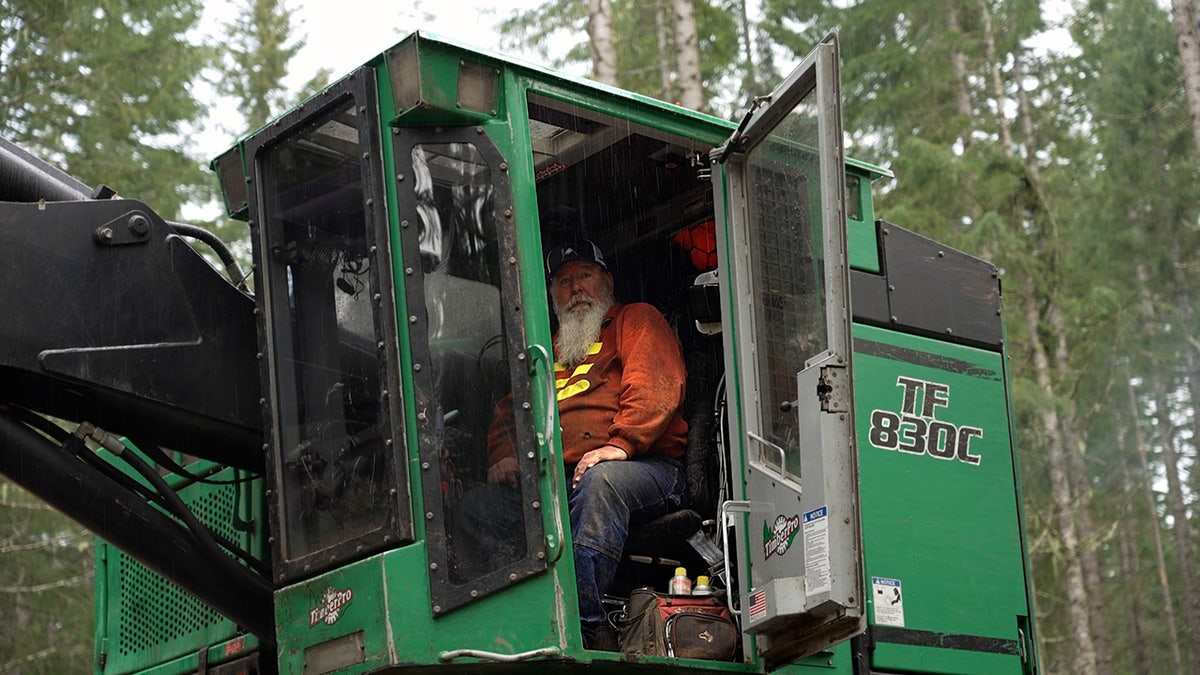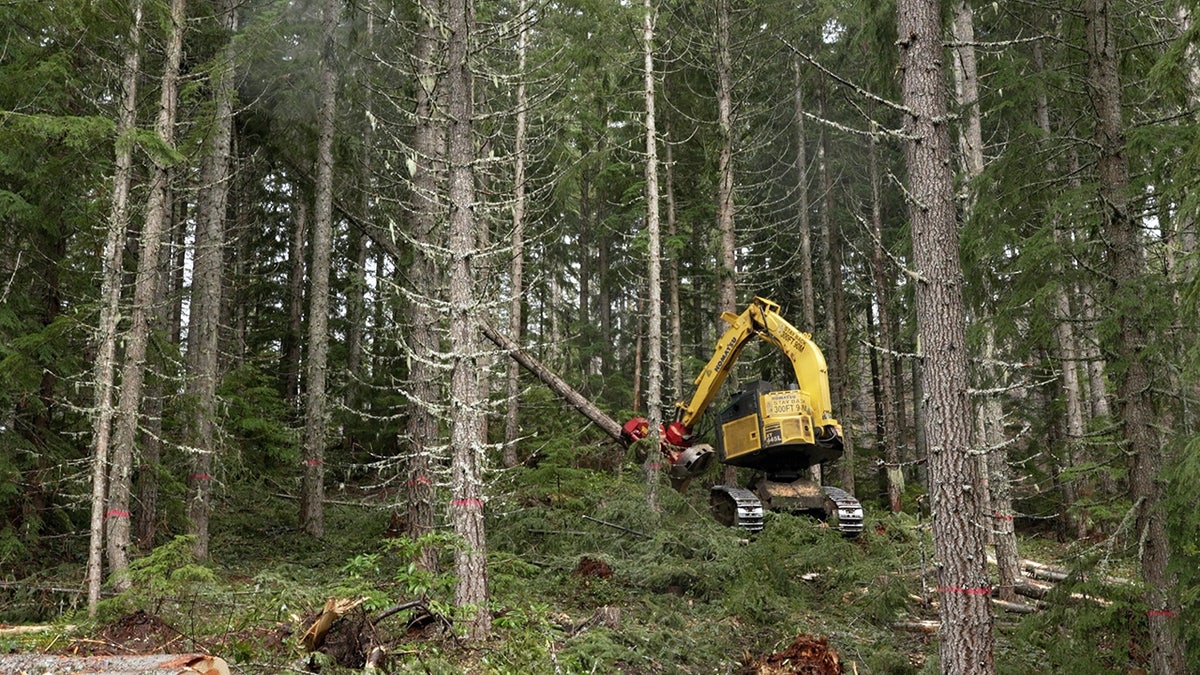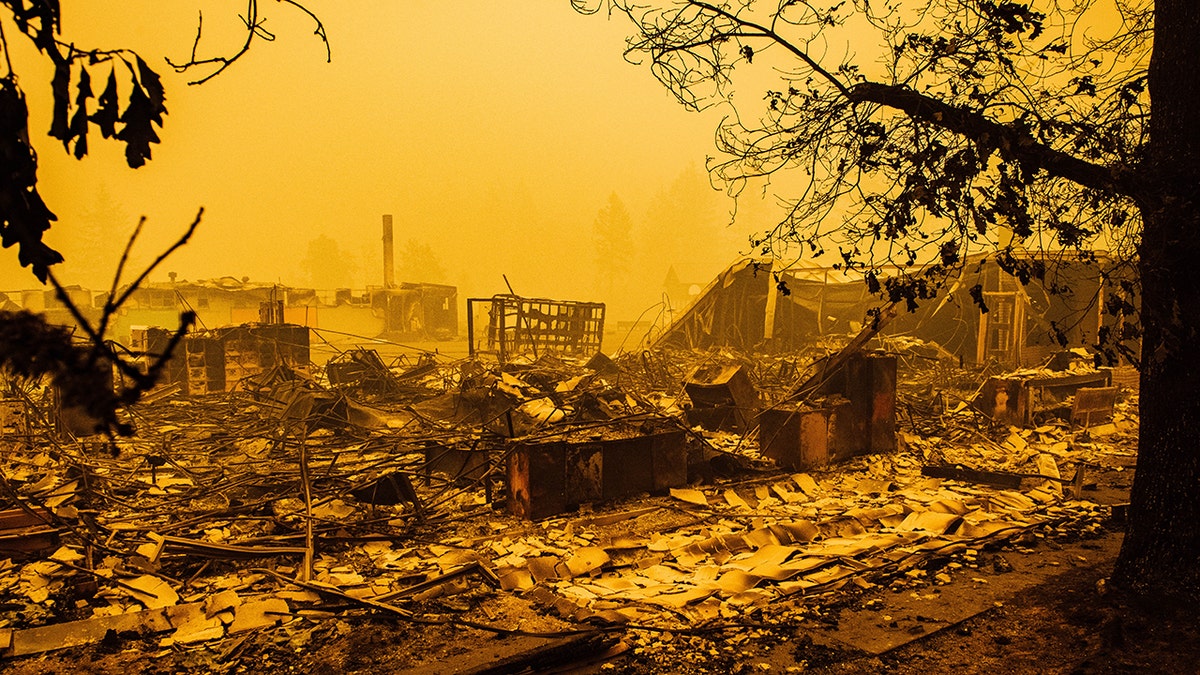

LINN COUNTY, Ore. – The buzz of saw teeth and scent of crushed pine needles filled the air as Roy Blackburn walked up a muddy path tucked away in the Willamette National Forest, invisible from the forest service road below.
He climbed into the cabin of his TimberPro 830C forwarder and began picking up felled trees that had been stripped of their branches. Sled-sized slabs of bark rained down as he hoisted tree after tree through the air and stacked them on the back of a trailer.
Blackburn has worked in the timber industry for more than 40 years, following in the footsteps of both his father and older brother.
"There’s just no better place to be," he said.

Roy Blackburn has worked in Oregon's timber industry since 1982. (Hannah Ray Lambert/Fox News Digital)
TRUMP ADMINISTRATION TO OPEN 13 MILLION ALASKA ACRES TO MINING, DRILLING
Timber once drove the economies of states like Oregon. But forest harvests nosedived beginning in the early 1990s due to stricter environmental regulations, a changing lumber market and other factors.
President Donald Trump hopes to reverse that trend by executive fiat, ordering the U.S. Forest Service to ramp up logging on federal lands in what environmental groups like Earthjustice call a "cynical attempt to justify destructive logging."
"It's really just about lining the pockets of timber industry executives," Blaine Miller McFeely, a senior legislative representative at Earthjustice, a nonprofit environmental law group, told Fox News Digital.
Controversial logging methods like clear-cutting that were popular as settlers moved west drew vast public backlash starting around the 1970s. Environmental legislation, particularly the Northern spotted owl's designation as endangered in 1990, dealt a crippling blow to logging on federal lands.
The amount of timber harvested on Forest Service land has decreased nearly 80% since reaching a high in 1987, according to government data.
That's had a severe impact on timber towns.
Tyler Freres, whose grandfather opened the family's first sawmill back in 1922, said federal agencies used to offer 200 million board feet for timber production in Oregon's Santiam Canyon. Now, he said, that's down to 1 million board feet per year.
"I remember as a child the amount of prosperity that existed within our rural communities," Freres said. "There was a lot of timber dollars flowing back in the day and those dollars went directly into our local services."
At least seven Oregon lumber mills closed in 2024 alone, cutting hundreds of jobs, primarily in rural parts of the state. Just across the Columbia River, a plywood mill in Washington is slated to close this month, taking 81 jobs with it.
LEFT'S 'APOCALYPTIC' ENVIRONMENTALISM PUSHED AWAY CONSERVATIVES, SAY RIGHT-LEANING CONSERVATIONISTS
"The federal government owns most of Oregon's forests. So, many of our communities throughout the state, from a social [and] economic standpoint, are really dependent on what happens with federal lands," Nick Smith of the American Forest Resources Council, which advocates for the timber industry, told Fox News Digital.

Tyler Freres, vice president of sales for Freres Engineered Wood, visits a logging site in the Willamette National Forest on May 20, 2025. The forest spans nearly 1.7 million acres, larger than the state of Delaware. (Hannah Ray Lambert/Fox News Digital)
As U.S. mills close, the country has come to rely on lumber from other countries such as Canada, China and Brazil.
"They're all using U.S. as a target for all their wood products, while the reduction in timber supply has made our raw materials prices skyrocket," Freres said.
Canadian competition was on Trump's mind in March when he signed an executive order to immediately expand timber production on federal lands.
"We don't need Canada's lumber," Trump said. "Our forests are massive, massive forests, we just aren’t allowed to use them because of the environmental lunatics that stopped us."
The executive order and subsequent implementation plans direct the Forest Service to increase timber production by 25% over the next four to five years.
A spokesperson for the Forest Service told Fox News Digital the agency will strive to sell 4 billion board feet by fiscal year 2028, a figure not reached since the early '90s.
They hope to accomplish this with a strategy heavy on streamlining processes and trimming regulations, as well as expediting project approvals. USDA Secretary Brooke Rollins, whose agency oversees the Forest Service, recently announced a $200 million investment to support this work.
But the plan also directs the Forest Service to accelerate environmental reviews and "streamline compliance." Miller McFeely slammed the Trump administration for implementing this guidance after "gutting" the Forest Service. Thousands of employees left the agency under Trump's deferred resignation offer earlier this year.
"There is no way that you are going to be able to get [a 25% increase] in a smart, reasonable way … because they don't have the staff to go out and actually do site-specific analysis," Miller McFeely said.
Rollins told Fox News Digital that previous administrations allowed environmental groups to drive "the decision-making on our forests." That's changing under the Trump administration.
"Having a clean and healthy forest is such an important goal," Rollins said. "This president is not beholden to these environmental groups."
The Forest Service said most of the nation's 154 national forests will be impacted by the order, but to varying degrees. The agency does not have "specific information on how each individual forest will be affected just yet," a spokesperson wrote in an email.
That lack of specificity has environmentalists like Miller McFeely worrying that loggers will "literally be clear-cutting in the back country." He pointed to the plan's inclusion of Alaska's Tongass National Forest, a remote temperate rain forest.
"That's old growth," he said. Loggers are "gonna go after the biggest, oldest trees that are the best at protecting communities, as opposed to focusing on the small stuff that are the most threatening to communities."
But those in the timber industry say the old-growth trees treasured by nature lovers aren't the primary target for modern logging.

A logger cuts down trees for Freres Engineered Wood. Pink lines mark trees that will be left standing. (Hannah Ray Lambert/Fox News Digital)
In Oregon, processing infrastructure has shifted to focus on smaller, denser trees that grow in the understory of larger trees.
"They allow us to make a lot of precise engineered wood products," Freres said. "We're not out there hunting out the biggest trees."
BLUE STATE RANCHERS THROWN ‘TO THE WOLVES’ SEEK PRESIDENT TRUMP’S RESCUE
At the logging site in the Willamette National Forest, Blackburn pointed across the clearing.
"If you look right across the way over there, you can see lots of old growth and probably 25-plus percent is all dead," he said. "It just died of natural causes. And what's over there has a lot of rot, and it has white speck and it's not very desirable for any of the timber companies."
Wildfires, insects and disease are killing far more trees on federal lands than logging is, according to Forest Service reports. That’s especially true for old-growth trees, which have lost almost 1,400 square miles due to natural causes since 2000, according to a government report, compared to around 14 square miles of logging-related losses.
"Our forests are dying because we're not managing them," Smith said. "We are in a national wildfire crisis where millions of acres of national forest lands are overstocked."
Wildfires that began on public land in August 2020 in the Santiam Canyon area took off over Labor Day weekend, killing five people and burning more than 400,000 acres.
Blackburn lost his home in the fires.
"I was completely burnt out," he said. But he wasn't surprised to see the canyon burn.
"It was going to happen. There's nothing that goes on for any type of preventative maintenance in this forest," he said. "When a fire starts, what's going to slow it down? It has no fire breaks."

Wildfires scorched more than 400,000 acres in the Santiam Canyon area in September 2020. Here, the charred remains of the Gates Elementary School are pictured. (Kathryn Elsesser/AFP via Getty Images)
The timber industry saw the fires as a bittersweet "I told you so" moment.
"Our neglect of these forests for the last 30 years has resulted in something that's very predictable," Freres said. "If we don't manage our own natural resources, Mother Nature will do it for us, and she will do it very violently."
Nearly five years after the devastating fires in Oregon, the landscape still bears scars. Invasive scotchbroom paints the hillsides yellow, thriving without competition from native shrubs and trees that used to dominate the landscape. Charred snags and gray corpses of diseased trees line the roads.
The Forest Service planned to remove trees like this, as well as fuels like brush and branches, along hundreds of miles of roads after the 2020 fires, but scrapped the plan in 2022, citing lawsuits from local environmental groups.
Earthjustice wasn’t involved with that litigation, but generally opposes removing snags unless they present a clear danger to communities, like falling on roads.
"We need those dead trees that have been burned," Miller McFeeley said, adding that wildfire is a valuable part of forest health.
"If you go into a forest after it’s burned, in the next couple of years it is just a beautiful place with wildflowers and birds … because what it’s done is it’s opened up all of the pinecones and released these seeds and everything is starting to grow," he said. "Salvage logging completely disrupts that. It's also extraordinarily bad for erosion and soil and water quality and health."
Trump's executive order calls logging a key element of wildfire prevention, and one of four focus areas outlined by the Forest Service calls for increased salvage harvest, hazard tree removal and reforestation actions to be carried out faster after disturbances like wildfires.
While executive actions are often temporary since the next administration can simply override them, those in the timber industry are optimistic that attitudes toward forest management are changing across party lines.
Earlier this year, the House passed the Fix Our Forests Act, which seeks to reduce wildfire threats by expediting some forest management projects and reducing litigation. Notably, it received bipartisan sponsorship and 64 Democratic representatives voted in favor of the bill. A Senate version of the bill also received bipartisan sponsorship.
"We are in an era of megafires," Smith said, ones that are now blanketing "entire regions" of the country with wildfire smoke every summer, not just rural areas. He believes that's starting to unite leaders in blue states who traditionally opposed logging.
Numerous environmental groups have spoken out against both versions of the Fix Our Forests Act, arguing they disregard science and chip away at important conversation laws.
"You can't put a tree back up when you realize that you've cut the wrong way, or the wrong tree, or wrong place. It's too late," Miller McFeely said. Representatives are "going to just facilitate bad logging in bad places and give the keys to the Trump administration to clear-cut our lands that we all own."
Freres reflected on the devastating 2020 Oregon wildfires and said he hopes "something good can come from these tragedies."
"The politicians can finally get on the side of supporting our local citizens through good, hard work in the forest, where people can have a little bit of sawdust in their veins and a little bit of dirt underneath their fingernails and really start working to take care of these natural resources," he said.
